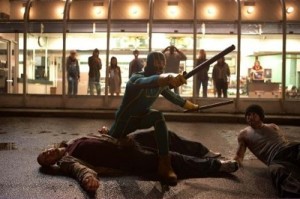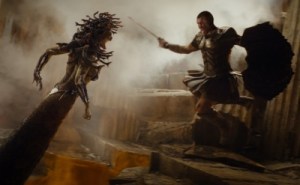
With January and February showing signs of life over the last two years April is now the pre-summer season dumping ground for the also-rans, the never-weres, and The Losers. Furry Vengeance? That had ”late April” stamped on the film canisters the day someone dreamed up the title.
Hopes were surely higher for Kick-Ass. But all the movie does is prove that what kicks ass at Comic-Con can get its ass kicked at the multiplex. The comics fanboys deserve some credit for keeping the studios a little honest in their whorish pursuit of graphic novel gold; the movies that result, bad as they can be, are possibly better for their whining/criticism, which has Hollywood’s ear. What works on the page, though, doesn’t always excite the general public, and Kick-Ass combines two cold case genres: the superhero spoof/parody/commentary/what-have-you, and the sadistic, over-the-top, vaguely funny action movie. Mystery Men plus Shoot ’Em Up corpses for anyone who has to consult the IMDb to remember two movies with this one’s DNA.
 I give the filmmakers credit for sticking to their guns…and knives, and garrotes, and bazookas, and man-sized microwave ovens. The prior movie based on a comic by Mark Millar, Wanted, was an epic of sociopathic hostility, and this one, no day at the beach either, puts kids on the firing line—weapons in hands. With its severed limbs and arterial sprays and mega-sized bullet and body counts you can’t say Kick-Ass was watered down for a PG-13, or that the ”good stuff” was saved for an unrated DVD somewhere down the filmic food chain. This is full-strength and R-rated, bitches. Trouble is, when your marketing is primarily built around an 11-year-old superheroine, you’ve got a problem, tantalizing the kids her age (”a girl is a superheroine in a movie!”), confusing their parents (”a girl is a superheroine in an R-rated movie?”), and leaving an audience that’s not necessarily in on the joke dumbfounded (”a girl is a superheroine in an R-rated movie—why do I want to see that?”)
I give the filmmakers credit for sticking to their guns…and knives, and garrotes, and bazookas, and man-sized microwave ovens. The prior movie based on a comic by Mark Millar, Wanted, was an epic of sociopathic hostility, and this one, no day at the beach either, puts kids on the firing line—weapons in hands. With its severed limbs and arterial sprays and mega-sized bullet and body counts you can’t say Kick-Ass was watered down for a PG-13, or that the ”good stuff” was saved for an unrated DVD somewhere down the filmic food chain. This is full-strength and R-rated, bitches. Trouble is, when your marketing is primarily built around an 11-year-old superheroine, you’ve got a problem, tantalizing the kids her age (”a girl is a superheroine in a movie!”), confusing their parents (”a girl is a superheroine in an R-rated movie?”), and leaving an audience that’s not necessarily in on the joke dumbfounded (”a girl is a superheroine in an R-rated movie—why do I want to see that?”)
The real problem, however, is that the joke is only funny-shocking once, and doesn’t improve through overkill. The director, Matthew Vaughn, is primed to do justice to Millar, just as his heart was in the right place for the Neil Gaiman-based Stardust. The results are again only intermittently successful—that film had inspired turns by the likes of Michelle Pfeiffer and Robert De Niro to carry the day, this one runs out of inspiration once a scene of bloody carnage is set to the Banana Splits TV theme. And, for all her trash talk and firepower, Chloe Moretz’s Hit Girl (part of a rag-tag group of costumed crimefighters that includes her morose ex-cop dad, played at about a 7 on the eccentricity scale by Nicolas Cage, and the title character, a not-terribly-compelling high school dweeb by day portrayed by straining-to-be-American Brit actor Aaron Johnson, to be seen in October as John Lennon in Nowhere Boy) doesn’t make more than an immediate impression, fading into the vengeance-laden tedium before long. This does not bode well for the forthcoming American remake of Let the Right One In, where her casting a spell on us is crucial.
Far be it from me to blame Kick-Ass’ failure on a little girl. This is, after all, a movie from scuzzy Lionsgate, progenitor of Saw, Hostel, and The Punisher—not a warm fuzzy or an improving thought in the bunch. Vaughn may just have loved too much as director, co-producer and co-screenwriter, appeasing a tiny cult. (I knew the movie was dying when someone in my audience asked, audibly, ”Why is Nicolas Cage talking like that?”—that is, in obvious homage to Adam West on Batman, which if you don’t get basically nulls-and-voids the rest of it.) His storytelling is a drag. This is one of those media-saturated movies where an action is captured via a video camera, and everyone spends a lot of time looking at it, so a good chunk of the film is us looking at supporting characters observing the leads on their laptops, surveillance equipment, and the TV news. Oh, how I wish the movies would live off the grid again.
As for the whole kids and violence debate, well, if Kick-Ass had kicked up more than a brief kneejerk debate on the subject I might be persuaded to interject, mentioning that we’re a long way from the starker reality of Jodie Foster in Taxi Driver and in that usual never-never land where pain and bloodshed are pretty much divorced from suffering. Does that let Kick-Ass off the hook? I don’t know. Better to ask co-producer Brad Pitt, and find out when he intends to let his brood watch the movie.
[kml_flashembed movie="http://www.youtube.com/v/DrKHu2UX1vA" width="600" height="344" allowfullscreen="true" fvars="fs=1" /]
The release of Clash of the Titans was held up for a week as the film was converted for 3D. What I saw on the screen strongly suggested that it took a couple of hours, at most, to do the job. There are no 3D effects in the film, just slight fuzz brushed onto the image to make it look as if Liam Neeson and Ralph Fiennes were going to pop out of the screen at any moment, and there’s no need for the ludicrously surcharged glasses ($4 at my Brooklyn theater). The ”added feature” amounts to consumer fraud, and the perps should be hauled into movie jail posthaste.
I sidestepped the ripoff by bringing my own pair of glasses (ignore the return box and keep one or two; I have five pairs of the damned things sitting in my desk drawer) and buying a ticket for a regular-priced movie, and I urge you to do the same the next time another faux 3D movie is foisted upon us. It’s only just, in that in every respect Clash of the Titans is at best two-dimensional. The movie goes out of its way to take a swipe at the 1981 original, which isn’t hard to do; though it has a starrier cast than this one (Laurence Olivier, Maggie Smith, etc.) it is for better or worse the last gasp of the kind of the fantasy filmmaking rendered obsolete by Star Wars. The new one fixes obvious flubs in its source (the fearsome Kraken, which bookends the first one and upstages itself, waits in the wings for maximum impact in this one) and is as tolerable as an average timewaster on Syfy.
But it’s also as disposable. What makes the original special is of course its menagerie of creatures, designed in his filmic farewell by Ray Harryhausen. They’re not his best work, yet they have that wonderful handmade quality of his, and the film takes care to give them their proper due. Shoehorned into a Lord of the Rings-type quest scenario, the new Perseus (played with the same static glower Sam Worthington brought to his previous turns as half-humans in Terminator Salvation and Avatar) and his crew don’t seem particularly awed or surprised at the outsized scorpions and other computerized critters that block their way; they’re mildly peeved, as if they hit traffic outside the Holland Tunnel. If the filmmakers can’t get excited, we can’t either. (Director Louis Leterrier made the indifferent Incredible Hulk, another fantasy with all the thrills of a Tuesday at the office.) What Harryhausen’s film has going for it, 30 years later, is a love of craft, which can’t be faked on the workstation.
Like I said, though, tolerable, and there are stirrings of a more thoughtful picture here, as the humans voice their resentment at the gods, who take a tough-love approach to their creations and can’t fathom our disobedience. Zeus and Hades, though, have nothing on Leterrier and his editors, who burn through a good cast of supporting players, some of whom are onscreen for seconds and have next to no dialogue. I noticed, between eyeblinks, Pete Postlethwaite, Liam Cunningham, Polly Walker, Danny Huston, Alexander Siddig, Nicholas Hoult (A Serious Man), Jane March (The Lover), and Elizabeth McGovern—who also appears, in flashbacks, as Hit Girl’s mom in Kick-Ass. I’ve always liked McGovern, haven’t seen her in some time, and thank the movie gods for delivering her to me twice in a month.
[kml_flashembed movie="http://www.youtube.com/v/rcdP8YAW-8A" width="600" height="344" allowfullscreen="true" fvars="fs=1" /]
The 3D conversion for Clash of the Titans was done, I assume on the cheap, in Korea. Coincidentally, the country’s most expensive movie, the ”kimchi Western” The Good, The Bad, The Weird, has opened here. Seventeen million dollars buys you about three-quarters of Sandra Bullock’s quote in Hollywood but pays for a splashy widescreen epic overseas, with elaborate, stunt-packed chases on trains, horseback, and motorcycles, a massive den of thieves set reminiscent of ”Bartertown” in Mad Max Beyond Thunderdome, and location shooting deep in the deserts of China. Not too much of that, I think, went into the crazy-quilt script, which can barely contain it all, and doesn’t end so much as stop, huffing and puffing.
 What it lacks in cohesion it makes up for in style and setpieces. Director, co-writer and co-producer Kim Jee-woon is one of the country’s best filmmakers (of the gangster picture A Bittersweet Life and the outstanding horror film A Tale of Two Sisters, sloppily remade here as The Uninvited) and brings his double-barreled love of Italian-made spaghetti Westerns to the fray. While the movie plays off conventions of the genre (the train robbery sequence is a lively homage to Once Upon a Time in the West) it substitutes the amoral fatalism of Sergio Leone’s films with the action choreography of Steven Spielberg circa Raiders, not a bad trade. Set in 1930s Manchuria it’s enjoyable in fits and starts, and climaxes with a multi-vehicle chase with the title characters, the Japanese army, and Asian bandits in hot pursuit of a treasure map through the sands.
What it lacks in cohesion it makes up for in style and setpieces. Director, co-writer and co-producer Kim Jee-woon is one of the country’s best filmmakers (of the gangster picture A Bittersweet Life and the outstanding horror film A Tale of Two Sisters, sloppily remade here as The Uninvited) and brings his double-barreled love of Italian-made spaghetti Westerns to the fray. While the movie plays off conventions of the genre (the train robbery sequence is a lively homage to Once Upon a Time in the West) it substitutes the amoral fatalism of Sergio Leone’s films with the action choreography of Steven Spielberg circa Raiders, not a bad trade. Set in 1930s Manchuria it’s enjoyable in fits and starts, and climaxes with a multi-vehicle chase with the title characters, the Japanese army, and Asian bandits in hot pursuit of a treasure map through the sands.
The Good (Jung Woo-sung), a bounty hunter, and The Bad (Lee Byung-hun), a vain criminal leader, pretty much stick to stereotype and are unremarkable (except that they, like everyone else, performed their own tricky stunts). Giving Eli Wallach a run for his money as The Weird, a rascally train robber, is Song Kang-ho. A familiar Everyman face at art houses courtesy of Bong Joon-ho’s hits The Host and Memories of Murder, Song (pictured) zips through the picture in a sidecar motorcycle like John Belushi in 1941, as ”Don’t Let Me Be Misunderstood” roars on the soundtrack. No misunderstanding here: In any language, Song has star power. The Good, The Bad, The Weird could use a few fanboys.
[kml_flashembed movie="http://www.youtube.com/v/Zjm9gAjgRuU" width="600" height="344" allowfullscreen="true" fvars="fs=1" /]
Finally, as No Concessions grinds into gear after a month off, a word about Sandra Bullock. No Concessions is never far from a word about the newly anointed Oscar winner (Sandra, if you had only listened to me about Jesse James…) and today I speak of The Proposal, which I saw on Starz last week. It’s more a first draft for a rom-com than an actual romantic comedy, as if the filmmakers said ”This is cute, but wouldn’t if be more romantic and more comedic if we just did this?” then decided that, what the hell, the bare minimum of the script would work with audiences. And moviegoers, transported by the sight of Betty White in a Native American headdress, agreed, as the thing earned a bazillion and two dollars last summer.
In the only artfully directed sequence in the picture, Sandra and co-star Ryan Reynolds stumble all over each while stark naked, giving us the impression of seeing everything while cleverly preserving the PG-13 rating. I’m not made of stone—I laughed (and freeze-framed through to see if the MPAA missed anything. Sad to say they were on the job). Then I winced, just as I did when Diane Keaton and Jack Nicholson did the same thing in Something’s Gotta Give. What grownup acts this way? You excuse yourself and quickly exit the room, like an adult—or, if you look like Sandra and Ryan, demigods who look unalike any New York book publishing people I know, you cut to the chase and settle in for a major boning session. Right?


![Reblog this post [with Zemanta]](http://img.zemanta.com/reblog_e.png?x-id=43486f10-6523-46dc-804f-acb43f3ab0fc)



Comments